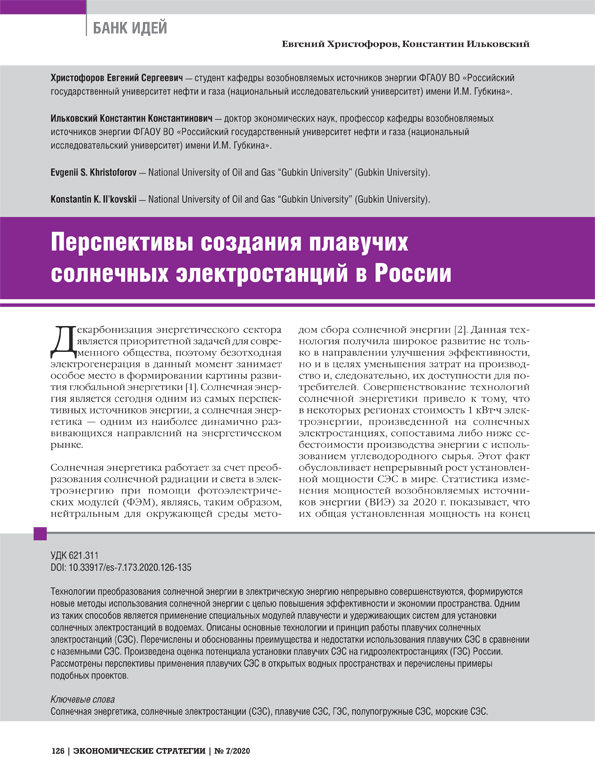Prospects of Сreating Аloating Solar Power Plants in Russia
DOI: 10.33917/es-7.173.2020.126-135
Technologies for converting solar energy into electrical energy are constantly improved, new methods of using solar energy are emerging in order to increase efficiency and save space. One of such methods is application of special buoyancy modules and restraints systems for installing solar power plants in water basins. The main technologies and operation principle of floating solar power plants (SPP) are described. Advantages and disadvantages of using floating solar power plants in comparison with ground-based solar power plants are listed and substantiated. Assessment of potential of installing floating SPP at hydroelectric power plants (HPP) in Russia is given. Prospects for the use of floating SPP in open water areas are discussed and examples of such projects are listed
References:
1. Future of Solar Photovoltaic: Deployment, investment, technology, grid integration and socio-economic aspects (A Global Energy Transformation: paper). IRENA, International Renewable Energy Agency, Abu Dhabi, 2019, November, available at: https://irena.org/publications/2019/Nov/Future-of-Solar-Photovoltaic.
2. Arno H.M. Smets. Solar Energy — The physics and engineering of photovoltaic conversion, technologies and systems. UIT Cambridge, England, 2016, available at: https://www.researchgate.net/publication/304658624_Solar_Energy_-_The_physics_and_engineering_of_photovoltaic_conversion_technologies_and_systems.
3. Renewable capacity statistics 2020. IRENA, International Renewable Energy Agency, Abu Dhabi, 2020, available at: https://www.irena.org/publications/2020/Mar/Renewable-Capacity-Statistics-2020.
4. Rosa-Clot M., Tina G.M. Submerged and Floating Photovoltaic Systems. Academic Press, London, England, 2018, available at: https://www.elsevier.com/books/submerged-and-floating-photovoltaic-systems/rosa-clot/978-0-12-812149-8.
5. Martin-Chivelet N. Photovoltaic potential and land-use estimation methodology. Energy, 2016, no 94, pp. 233–242, available at: https://ideas.repec.org/a/eee/energy/v94y2016icp233-242.html.
6. Suh J., Jang Y., Choi Y. Comparison of Electric Power Output Observed and Estimated from Floating Photovoltaic Systems: A Case Study on the Hapcheon Dam, Korea’. Sustainability, 2020, no 12 (276), available at: https://www.researchgate.net/publication/338233541_Comparis on_of_Electric_Power_Output_Observed_and_Estimated_from_Floating_Photovoltaic_Systems_A_Case_Study_on_the_Hapcheon_Dam_Korea.
7. Lee N. Grunwald U., et al. Hybrid floating solar photovoltaics-hydropower systems: Benefits and global assessment of technical potential’. Renewable Energy, 2020, no 162, pp. 1415–1427, available at: https://www.sciencedirect.com/science/article/abs/pii/S0960148120313252?via%3Dihub.
8. World Bank Group, ESMAP and SERIS. Where Sun Meets Water: Floating Solar Market Report’, available at: https://openknowledge.worldbank.org/handle/10986/31880.
9. Golroodbari S.Z., van Sark W. Simulation of performance differences between offshore and land-based photovoltaic systems’. Progress in Photovoltaics, 2020, no 28, pp. 873–886, available at: https://onlinelibrary.wiley.com/doi/abs/10.1002/pip.3276.
10. Il’kovskii K.K., Il’kovskii D.K. Solnechnyi svet protiv uglya [Sunlight Against Coal]. Ekonomicheskie strategii, 2020, no 3, pp. 134–144, DOI: 10.33917/es-3.169.2020.134-141.



